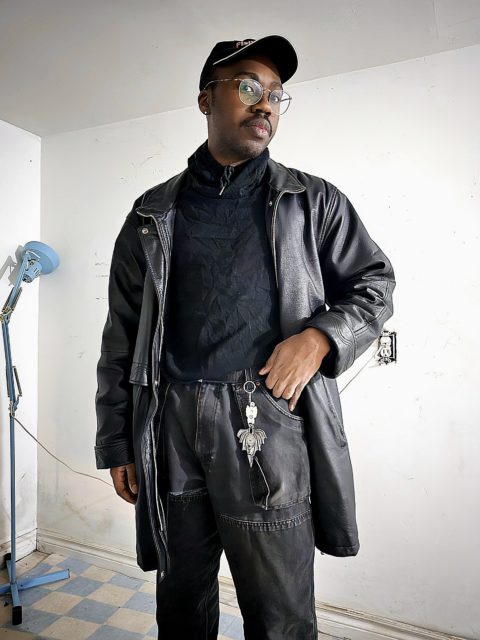The racialized experience of finding your own style amidst the microtrends, cores and aesthetics.
Everyone dressed the same in the suburban neighbourhood where I grew up. The uniform consisted of graphic tees, heather grey sweatpants from Roots and canvas camo print jackets from American Eagle. While this homogeneity was difficult to navigate as a Black queer kid in a small town, it was the catalyst for an obsession with expressing my identity through disruptive fashion.
I spent my teenage years pouring over Black creatives on my Tumblr feed, like Balmain creative director Olivier Rousteing during the fashion house’s arguably flashiest era and writer Rian Phin‘s love of loud eye-ball print pieces from the KESH x American Apparel collection.
Once Tumblr’s reputation as a resource for all things “cutting edge” waned, I was hesitant to embrace the many microtrends popularized on TikTok. The digital landscape in the post-Tumblr era is an entirely different maze to navigate and without my cultural compass to guide me, I felt exposed and unremarkable. Now, apps like TikTok are marketing identities for me to fit into when I barely have a grasp on my own.
The good thing about my suburban echo chamber was knowing the limitations that were built around my identity and how to surpass them; to do this through fashion empowered me. But seeing the art form that I used as armour to protect me from bigotry be used as a marketing tool, at times aestheticizing the microaggressiveness of the Western-European fashion I grew up with (see: the “clean girl” aesthetic), made me disillusioned. It caused me to question whether fashion was still a space for singular voices if it contained all these disposable multitudes. Was my voice authentic by comparison?
In my closet hangs a green zebra print Kenzo jumpsuit, a rhinestone beaded logo T-shirt from club wear brand MISBHV. I’d spent years collecting pieces like this as a way of affirming my individuality. But feeling like everyone was moving on in their style journey without me — even if they were embracing all the same TikTok microtrends — made me realize I was actualizing a small town prophecy in my own closet: staying the same and avoiding growth.
The way that trends like the mob wife aesthetic and fairycore appear and disappear at breakneck speed convinces me that disruption is only as effective as it is timely. I’m 25 now, no longer living to escape the prejudice-infested neighbourhoods of my youth. Last year, reading bell hooks’ 1992 collection of essays Race and Representation helped me come to this realization. She highlights the challenge of building representation around reactions to prejudice, essentially allowing Western-European standards to insidiously center themselves in the lives of Black folks.
I decided that the most healing, freeing gift I could give myself was to embark on a mission: I would experiment with different aesthetics and see which one (or ones) felt right. Here’s what I learned about myself through trying three fashion microtrends.
The office siren

I fell hard for the office siren look. As a Prada collector, I’ve always been a big fan of geek chic and all its manic, brocade-woven glamour. But if the chic geek screams, the office siren whispers. To embrace the office siren vibe, I immersed myself in the work of New York-based designer Mark Gong, whose work focuses primarily on black, grey or white bell-sleeve knit cardigans, slinky dresses with pin-thin spaghetti straps and sheer tights. The key to the office siren aesthetic is taking styles that are native to business dressing and injecting them with dramatic draping and sneaky slits of skin that wink at evening wear.
My summer 2023 was spent cutting up oversized pinstripe trousers from Value Village into Miu Miu-length short shorts. The old me would’ve paired them with loud button-ups but I chose an oversized white T-shirt and black wraparound shades instead; what makes this disruption so effective is being able to see the thought process behind the restraint.
Gorpcore

It excited me to get my hands dirty with gorpcore. I’d spent so much time making my clothes match my social environment that I never stopped to consider the natural environment growing around me. The gorpcore aesthetic takes practical, weather-focused, action-ready pieces and styles them in a streetwear context. My white Keds got soaked once the autumn rain came and I had to turn to a stronger companion, the Yeezy Boost 350 V2’s in the clay colorway.
Other great gorpcore finds included a thrifted vintage leather trench coat from Penningtons and nylon cargos from Dickies; all black and in large, body-obscuring silhouettes that provided me more protection and confident restraint than my Elmo-Red, vintage varsity bomber ever could.
Quiet luxury

Quiet luxury is like that guy who could change your life if you could just figure out how to get close to him. When I did, the aesthetic swept me off my feet. After spending a year styling clients in business casual styles at the ill-fated Nordstrom Canada, I studied my own methods before turning them onto myself. At the Californian-based label James Perse, I found staples that turned out to be the best basics I’d ever owned; finely woven cream cashmere sweaters, Japanese denim with the perfect slim-waist-to-wide-thigh ratio and grey french terry cotton sweats with a clean silhouette. Instead of scrambling to make a statement in a chaotic garment, it feels just as poignant to be wear an expertly crafted piece that was a no-brainer to casually slip on.
After a year of playing in the fashion space, the biggest lesson was that my journey for accurate representation of myself as a Black, queer person will never end. The beauty of that longevity is the way it affirms my identity against the expectations of Western-European standards without even trying, this identity innately refuses definition in the traditional sense. If fashion is ever-evolving, I choose to champion the growth of my communities by publicly growing with it.
